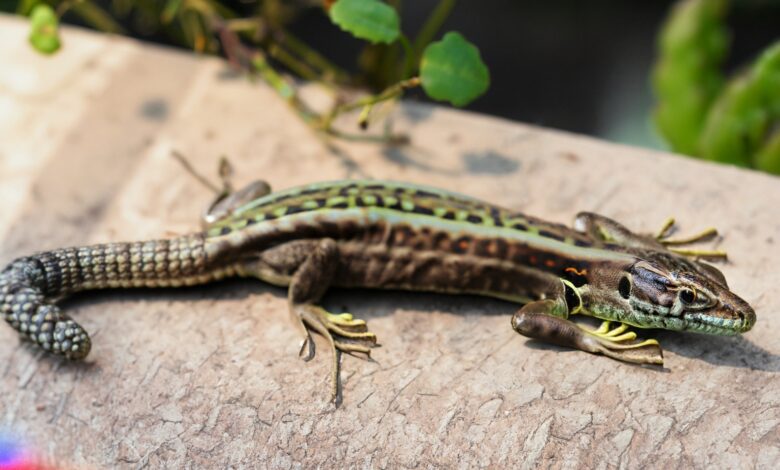What Do Backyard Lizards Eat?

What Do Backyard Lizards Eat? Unraveling the Diet of These Fascinating Creatures
Backyard lizards are adorable creatures that add a touch of nature to our surroundings. With their sleek bodies and graceful movements, these reptiles often bask in the sun or scurry around our garden walls. Have you ever wondered: What Do Backyard Lizards Eat? What fuels their active lifestyle? In this post, we explore the intriguing world of pet lizards and shed some light on their food preferences.
Understanding Backyard Lizards
Backyard lizards, commonly known as garden lizards or fence lizards, belong to the family Lacertidae and are found in various regions around the world. They are cold-blooded reptiles with scales covering their bodies, and their remarkable ability to regenerate lost tails has always fascinated scientists and nature enthusiasts alike.
These small to medium sized lizards are well adapted to living in a variety of environments including gardens, backyards and even urban areas. They play a critical role in maintaining the ecosystem by controlling insect populations and acting as prey for larger animals.
What Do Backyard Lizards Eat?
Backyard lizards are primarily insectivorous, which means their diet consists primarily of insects. Let’s dive into the specific types of prey that these wonderful creatures prey on to support their energetic lifestyle.
– Insects
Insects make up the bulk of a backyard lizard’s diet. They have an insatiable appetite for a wide range of insects, including:
- crickets
- grasshoppers,
- beetles,
- ants,
- termites,
- moths,
- and flies.
These agile reptiles often rely on their exceptional vision and quick reflexes to track down their prey.

– Spiders
Spiders are also among the dietary preferences of backyard lizards. Although most spiders can weave an intricate web to trap their prey, they are not immune to the nimble lizards that prowl the same area. Backyard lizards are adept at navigating this web or pouncing on spiders that get too close, making them a delicious treat in a lizard’s diet.
– Small Invertebrates
In addition to insects and spiders, backyard lizards also consume a variety of small invertebrates. These include:
- earthworms,
- snails,
- slugs,
- and even small crustaceans.
This diversity in their diet ensures that these lizards receive a wide range of essential nutrients.
Foraging Techniques of Backyard Lizards
Backyard lizards employ a combination of hunting techniques to capture their prey. Their keen eyesight allows them to detect the slightest movements of insects or spiders, enabling them to strike with precision. The following techniques showcase the lizards’ adaptability and agility in securing their meals.
– Active Foraging: Pursuing Prey on Foot
Backyard lizards are often seen actively foraging for insects. They move swiftly, stealthily, and low to the ground, using their long tongues to snatch up their unsuspecting prey. Their keen sense of smell guides them to areas teeming with insects, and they seize the opportunity to satisfy their hunger.
– Sit-and-Wait Strategy: A Tactical Approach
Some backyard lizards adopt a sit-and-wait strategy, perching themselves on fences, rocks, or tree branches. They remain still, camouflaging themselves among their surroundings, patiently waiting for insects or spiders to come within striking distance. This technique conserves their energy and allows them to capitalize on the element of surprise.
The Importance of Water for Backyard Lizards
Water plays a crucial role in the lives of backyard lizards. Although they derive moisture from their prey, lizards require access to fresh water for hydration. Birdbaths, shallow dishes, or even small ponds can be placed strategically in the backyard to provide a water source for these fascinating creatures. Maintaining a water feature not only benefits the lizards but also attracts a wider array of wildlife to your backyard.

Supplementing the Diet of Backyard Lizards
To create a healthy and inviting environment for backyard lizards, you can supplement their natural diet with additional food sources. Commercially available insect-based foods, such as mealworms or crickets, can be offered occasionally. However, it is crucial to ensure that these food items are free of pesticides and other harmful chemicals.
Encouraging Backyard Lizard Habitats
To support the presence of backyard lizards, consider creating a lizard-friendly environment. Planting native vegetation, providing rock crevices or small brush piles, and incorporating diverse hiding spots can enhance their habitat and attract a more substantial lizard population. Such efforts contribute to maintaining the ecological balance in your backyard and promote the well-being of these captivating reptiles.
Let’s Sum Up
Backyard lizards are captivating creatures that serve as valuable allies in controlling insect populations. Their diet primarily consists of insects, spiders, and small invertebrates, which they skillfully hunt using various techniques. By understanding their dietary preferences and providing suitable habitats, we can foster a thriving environment that supports these remarkable reptiles. Embrace the presence of backyard lizards and marvel at their ecological significance as they gracefully navigate your outdoor spaces.
Also Read
